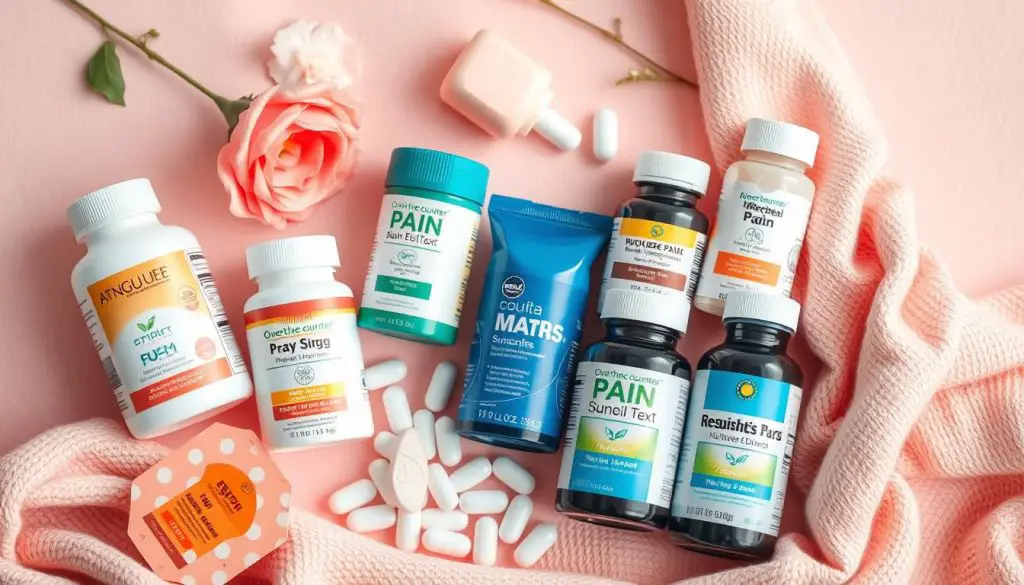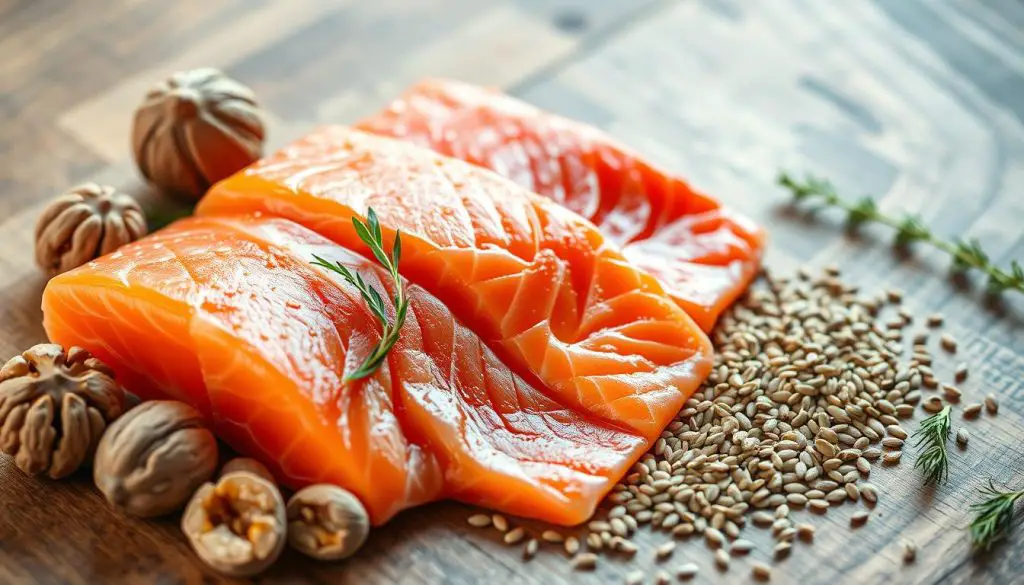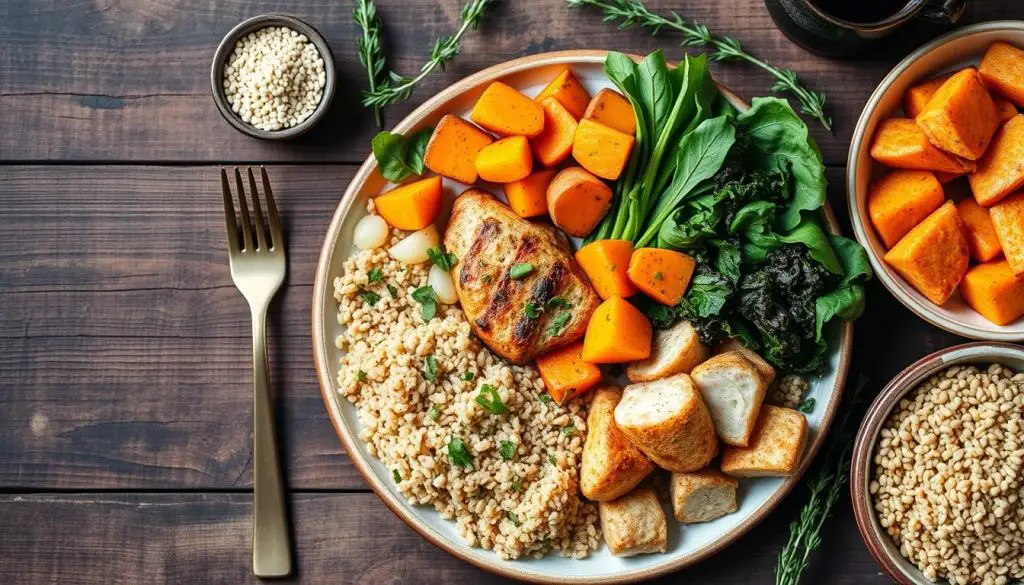If you’re among the millions with endometriosis, you know the pain it brings. Every month, menstrual cramps and pelvic discomfort can be overwhelming. But, there are many ways to find relief. This article will look at natural remedies and medical treatments to help you manage your pain.
Endometriosis affects 176 million women worldwide. It happens when tissue like the uterine lining grows outside the uterus. This causes inflammation, scarring, and adhesions, leading to severe pain and heavy bleeding. Luckily, there are techniques to ease your pain and improve your life.
Understanding Endometriosis and Its Impact
Endometriosis Definition and Causes
Endometriosis is a chronic condition where tissue like the uterine lining grows outside the uterus. This tissue can grow on ovaries, fallopian tubes, and other pelvic organs. It leads to inflammation, scarring, and adhesions.
The exact cause of endometriosis is not known. But it’s thought to involve genetics, immune system issues, and menstrual flow going backward.
Debilitating Symptoms of Endometriosis
People with endometriosis face many painful symptoms. These include severe menstrual cramps, pelvic pain, and painful intercourse. They also experience heavy or prolonged bleeding, fatigue, and infertility.
These symptoms can make everyday life hard. They can affect work, social life, and daily activities.
Endometriosis affects 7% to 15% of women worldwide. Women with infertility have a 25% to 50% chance of having it. Up to 30% of women experience severe menstrual pain, a key symptom of endometriosis.
Diagnosing endometriosis is tough because symptoms vary. There’s no reliable screening tool. Doctors often need surgery, like laparoscopy, to confirm the disease.
Early diagnosis and treatment are key. They help slow the disease’s progress and lessen symptoms over time.
Heat Therapy for Menstrual Pain Relief
Heat therapy is a simple and easy way to ease menstrual pain from endometriosis. Taking a warm bath or using a heating pad or hot water bottle on your lower abdomen can help. It relaxes the muscles and brings relief.
The warmth increases blood flow, which reduces inflammation and menstrual cramp pain. This makes it a great option for quick relief.
Research shows heat therapy works as well as over-the-counter pain meds. It’s a drug-free choice for those looking for relief.
- ThermaCare Menstrual Pain Therapy offers 8 hours of pain relief and has a 4.5 out of 5 star rating.
- The HeatWraps use special heat technology for proven pain relief. They’re thin and discreet, perfect for wearing under clothes.
- Targeted Heat Therapy for menstrual cramp pain relief lasts 8 hours. It’s a convenient and effective solution.
To use heat therapy, place the heating pad, hot water bottle, or ThermaCare HeatWrap on your lower abdomen. Let the warmth soothe your cramped muscles. Always follow the product instructions for safe use.
Heat therapy is just one way to manage menstrual pain. Regular exercise, pelvic massage, and changing your diet can also help. By trying these natural methods, you can find relief from endometriosis-related menstrual cramps.
Pelvic Massage: A Natural Approach
If you’re dealing with endometriosis pain, try pelvic massage. It’s a natural way to help. This massage targets the pelvic area. It aims to boost blood flow, cut down scar tissue, and relax muscles.
By working on the soft tissues in your lower abdomen and back, pelvic massage can ease endometriosis pain.
Benefits of Pelvic Massage for Endometriosis
Regular pelvic massage can help those with endometriosis a lot. Here are some benefits:
- Improved blood flow to the affected areas, which can help reduce inflammation and alleviate pain.
- Breakdown of scar tissue that can form as a result of endometriosis, providing greater flexibility and mobility.
- Muscle relaxation, which can ease the tension and cramping associated with the condition.
- Reduced stress and anxiety, as the massage can help promote a sense of calm and well-being.
Adding pelvic massage to your endometriosis care plan might make pain and discomfort easier to handle. Check out the latest clinical guidelines for endometriosis. They talk about pelvic massage and other natural remedies.
Over-the-Counter Pain Medications
NSAIDs and Their Role in Pain Management
For quick relief from endometriosis pain, over-the-counter NSAIDs are helpful. Ibuprofen (Advil, Motrin) and naproxen (Aleve) reduce inflammation. This is key in easing endometriosis pain and cramps.
Always talk to a doctor before taking pain medications for a long time. About 20% of people don’t see much improvement with NSAIDs for menstrual cramps. Some studies show acetaminophen (Tylenol) might not work as well for menstrual cramp relief.
| Medication | Potential Benefits | Considerations |
|---|---|---|
| Ibuprofen (Advil, Motrin) | Reduces inflammation, providing relief for endometriosis-related pain and cramping | Consult a healthcare provider before long-term use |
| Naproxen (Aleve) | Helps alleviate inflammation and cramping associated with endometriosis | Discuss appropriate dosage with a medical professional |
| Acetaminophen (Tylenol) | May not be as effective as other options for managing menstrual cramps | Potential liver damage with excessive or prolonged use |
It’s vital to work with a healthcare provider to find the best over-the-counter pain medication for you. This ensures safe use, even if you’re on birth control or have other health issues. With the right choice, NSAIDs can offer much-needed relief from endometriosis symptoms.

Dietary Modifications for Symptom Alleviation
Endometriosis can be tough, but changing your diet might help. Making smart food choices can cut down on inflammation and ease cramps. It can also boost your overall health.
Gluten-Free Diet and Endometriosis Pain
Research shows that a gluten-free diet might help those with endometriosis. A study found that 75% of people felt better after eating gluten-free for a year. This might be because gluten-free diets are anti-inflammatory.
Adding more fruits, veggies, whole grains, and healthy fats to your diet is good. Cutting down on processed foods, red meat, and dairy can also help. This can reduce inflammation and ease menstrual pain.
Keeping a food diary is helpful. It lets you see which foods affect your symptoms. This can help you find the best elimination diet for you.
Everyone’s body is different, so finding the right diet takes time. Be patient and keep trying. Talking to a healthcare professional can also help you find the best plan for managing your condition.
The Power of Rest and Relaxation
Living with endometriosis can make managing pain a big challenge. But, taking breaks to rest and relax can really help. It can reduce stress and tension that makes your endometriosis pain worse.
Try deep breathing exercises to help. Take a few minutes each day to breathe deeply. This can calm your body and mind, making you feel more relaxed.
Other good activities include listening to soothing music, going for a gentle walk, or practicing yoga or Pilates. These can help manage stress and improve sleep quality and well-being.
Research shows yoga can help with menstrual cramps. It targets the areas affected by endometriosis, providing relief.
So, make rest and relaxation a key part of your endometriosis plan. Take care of your mind and body. You might find your pain and discomfort eases.

It’s important to listen to your body and find what works best for you. With some trial and error, you can find the restorative power of rest and relaxation to help with endometriosis.
Herbal Supplements: Nature’s Remedies
Many people with endometriosis pain turn to herbal supplements as a natural choice. Some plant-based compounds might help with menstrual cramps and discomfort. But, more research is needed to confirm their effectiveness.
Turmeric: A Possible Anti-Inflammatory Aid
Turmeric is known for its anti-inflammatory properties. It can be found in capsules, teas, or meals. Turmeric’s active compound, curcumin, may help manage endometriosis pain by reducing inflammation.
| Herb | Potential Benefits for Endometriosis |
|---|---|
| White Peony | May help reduce inflammation and pain |
| Licorice | Possesses anti-inflammatory and analgesic properties |
| Sea Buckthorn and St. John’s Wort | Combination has shown promise in pain relief |
Quality, dosage, and purity of herbal supplements can vary. Always talk to a healthcare provider before adding new supplements. They can help with dosage and possible interactions.
Looking into herbal supplements and natural remedies can be a good part of managing endometriosis. But, it’s important to be careful and work with your healthcare team. This ensures your safety and well-being.
Omega-3 Fatty Acids: Combating Inflammation
If you’re dealing with the pain of endometriosis, adding omega-3 fatty acids to your diet might help a lot. Research shows these anti-inflammatory compounds can stop abnormal tissue growth and reduce inflammation.
Fatty fish like salmon are great sources of omega-3s. They have EPA and DHA, important omega-3s. Vegans and vegetarians can get omega-3s from flaxseeds, chia seeds, and algae supplements.
Studies found that omega-3s can lessen menstrual pain in endometriosis patients. In one study, people who took omega-3 supplements needed less ibuprofen for cramps than those who didn’t.
Omega-3s work by fighting inflammation, which helps with endometriosis pain. They can greatly improve life for those with this chronic condition.

Adding more omega-3 fatty acids to your diet or taking a supplement can help a lot. It could make a big difference in managing your endometriosis symptoms and finding endometriosis pain relief.
CBD Oil for Endometriosis Pain
If you’re dealing with endometriosis pain, you might have heard about CBD oil. It comes from the cannabis plant and is being looked at as a natural way to ease endometriosis pain.
Research shows that CBD might help by working with the body’s endocannabinoid system. You can find CBD oil in creams, ointments, and supplements. But, remember that CBD laws differ by state, so check your local laws before buying.
Even though there’s not a lot of research, many people say CBD oil helps them feel better. Some even use less pain medicine. Always talk to a doctor before trying CBD for your endometriosis.
| Key Insights | Data Points |
|---|---|
| CBD’s Possible Benefits |
|
| CBD Product Options |
|
| Research Limitations |
|
The idea of CBD oil helping with endometriosis pain is interesting. But, it’s important to be careful and get advice from a doctor. Knowing about CBD and its research can help you decide if it’s right for you.
Light Exercise: Boosting Endorphins
Light physical activity is good for those with endometriosis. It releases endorphins, which make us feel better. This can help lower endometriosis pain. Exercise also fights inflammation, improves health, and boosts movement.
Physical Therapy and Pelvic Floor Exercises
People with endometriosis might have weaker backs and less balance. It’s key to work with a physical therapist to create a safe workout plan. Pelvic floor exercises are also helpful in easing pain.
- Cramps usually get worse the day before and on the first day of your period.
- Severe cramps might cause some to miss school.
- Stretching and moderate exercise can ease menstrual cramps.
- Feeling tired is common at the start of your period.
- High-intensity workouts like running might not be best during heavy cramps. Yoga and breathing exercises are better.
- Cobra, Cat, Cow, and Fish poses help with heavy cramping.
- Hold each stretch for 30 to 60 seconds.
- Deep belly breathing is good during these exercises.
- Light aerobic exercises like walking or jogging are good for lighter days.
- Aerobic activities can reduce bloating, ease cramping, improve blood flow, and release endorphins.
A review of 12 trials with 854 women found that exercise may have a large effect on reducing menstrual pain intensity compared to no exercise. This is a 25 mm drop on a 100 mm scale, which is significant.
Medical Treatments for Endometriosis
Some people may need medical treatments to manage their endometriosis symptoms. These treatments include hormone therapy and surgical options. They are key in endometriosis management.
Hormone Therapy
Hormone therapy, like hormonal birth control or GnRH agonists, can control hormone levels. This helps stop endometrial tissue growth and eases pain. Hormonal contraceptives, for example, can regulate the menstrual cycle and lessen menstrual flow.
GnRH agonists stop estrogen production, slowing endometrial tissue growth. Over 80% of women using GnRH analogues see pain reduction, even with severe symptoms.
Surgical Options
For severe endometriosis, surgery might be needed. Removing endometrial lesions or even a hysterectomy can help manage symptoms.
While surgery can offer relief, it’s not a permanent fix. Symptoms can come back. It’s vital to work with healthcare providers to find the best treatment for each person’s needs.
Foods to Avoid for Endometriosis Relief
Endometriosis is a chronic condition that causes pelvic pain, heavy bleeding, and other symptoms. Eating anti-inflammatory and nutrient-rich foods is key. But, you should also limit certain foods that can make symptoms worse. These include gluten, caffeine, alcohol, soy products, dairy, red meat, and heavily processed items.
Keeping a food diary can help you track how different foods affect your symptoms. By making smart diet choices, you can manage your endometriosis better. This might help you find relief from your symptoms.
Gluten and Endometriosis
Studies suggest that a gluten-free diet can help those with endometriosis. In one study, 75% of women saw a decrease in pain after avoiding gluten.
Caffeine and Alcohol Intake
Drinking caffeine and alcohol can make endometriosis symptoms worse. Try to limit caffeine to 400 milligrams daily. Also, stick to one or two alcoholic drinks a week to avoid worsening your condition.
Dairy, Soy, and Red Meat
Staying away from dairy, soy products, and red meat can also help. These foods can lead to inflammation, which worsens endometriosis pain and discomfort.
Processed Foods and Inflammation
Processed foods are often full of unhealthy fats and added sugars. These can increase inflammation in your body. Eating whole, unprocessed foods can help manage your symptoms.
Remember, everyone’s body reacts differently to food. By paying attention to how certain foods affect you, you can create a diet plan that works for you. This can help you find the relief you need.

Seeking Professional Help and Support
Getting help for endometriosis is very important. You should see a healthcare provider, like a gynecologist. They can give you a correct endometriosis diagnosis and create a treatment plan just for you. Regular visits help your doctor keep an eye on your symptoms and adjust your care if needed.
Importance of Regular Check-ups
Seeing your healthcare provider often is key to managing endometriosis. They can do pelvic exams, order tests, and suggest surgeries. This helps them understand how serious your condition is and how it’s changing.
Working with a multidisciplinary care team is also great. This team might include experts in pain management, physical therapy, and mental health. They help you tackle all parts of endometriosis, from physical pain to emotional health.
Remember, regular check-ups and monitoring your symptoms are key to staying healthy with endometriosis. Don’t be afraid to ask for help and advice from your healthcare provider on your journey.
Unchecked Endometriosis: Possible Complications
If endometriosis is not treated, it can cause serious problems. These issues can greatly affect your health and how you live your life. The growth of endometrial-like tissue leads to chronic inflammation and scar tissue. This can cause severe pelvic pain, infertility, and problems with the bladder and intestines.
Endometriosis is a major cause of infertility, affecting at least half of those who struggle with it. It can also make pregnancy and childbirth more complicated. It can lead to incontinence, trouble with urination or bowel movements, and severe pain. This pain can hurt your social life, relationships, work, and studies.
It’s very important to work with your healthcare provider to manage endometriosis. This can help stop symptoms from getting worse and prevent complications. Early diagnosis and a treatment plan that includes medicines and sometimes surgery can lessen the effects of this condition.
Source Links
- https://www.mayoclinic.org/diseases-conditions/menstrual-cramps/diagnosis-treatment/drc-20374944
- https://www.medicalnewstoday.com/articles/321402
- https://www.endometriosis-uk.org/pain-relief-endometriosis
- https://www.mayoclinic.org/diseases-conditions/endometriosis/symptoms-causes/syc-20354656
- https://www.hopkinsmedicine.org/health/wellness-and-prevention/period-pain-could-it-be-endometriosis
- https://www.who.int/news-room/fact-sheets/detail/endometriosis
- https://www.thermacare.com/heat-wraps/menstrual-pain-therapy/
- https://www.healthline.com/health/womens-health/heating-pad-for-cramps
- https://www.healthline.com/health/womens-health/menstrual-cramp-remedies
- https://pressmodernmassage.com/blogs/going-deep/massage-for-period-cramps
- https://www.westendwellness.ca/blogs/massage-therapy-for-your-period-cramps
- https://repphysio.ca/massage/massage-therapy-for-your-period-cramps/
- https://www.cvs.com/shop/personal-care/feminine-care/menstrual-pain-relief
- https://www.verywellhealth.com/medicine-for-period-cramps-8420078
- https://www.pcrm.org/good-nutrition/nutrition-information/using-foods-against-menstrual-pain
- https://sesamecare.com/blog/period-cramp-relief-foods
- https://www.healthline.com/health/positions-to-help-period-cramps
- https://www.webmd.com/women/ss/slideshow-get-rid-of-cramps
- https://www.healthline.com/health/fitness/yoga-poses-for-period-cramps
- https://www.health.com/condition/menstruation/menstrual-pain-natural-remedies
- https://www.verywellhealth.com/herbs-for-menstrual-cramps-89901
- https://vivaeve.com/menstrual-pain-relief-may-be-found-in-omega-3s/
- https://www.ncbi.nlm.nih.gov/pmc/articles/PMC3770499/
- https://theiopn.com/reel-in-the-relief-can-omega-3s-reduce-menstrual-pain/
- https://www.endofound.org/cbd-oil-for-endometriosis-pain-experts-warn-buyer-beware
- https://www.medicalnewstoday.com/articles/cbd-for-menstrual-cramps
- https://www.ncbi.nlm.nih.gov/pmc/articles/PMC8547625/
- https://www.nationwidechildrens.org/family-resources-education/health-wellness-and-safety-resources/helping-hands/yoga-exercises-and-menstrual-cramps
- https://www.ncbi.nlm.nih.gov/pmc/articles/PMC6753056/
- https://www.mayoclinic.org/diseases-conditions/endometriosis/diagnosis-treatment/drc-20354661
- https://www.webmd.com/women/endometriosis/understanding-endometriosis-treatment
- https://www.healthline.com/health/endometriosis/endometriosis-diet
- https://health.clevelandclinic.org/endometriosis-diet
- https://www.medicalnewstoday.com/articles/321471
- https://www.ncbi.nlm.nih.gov/books/NBK279324/
- https://www.nhsinform.scot/healthy-living/womens-health/girls-and-young-women-puberty-to-around-25/periods-and-menstrual-health/period-pain-dysmenorrhoea/
- https://dramytomlinson.com/blogs/news/managing-painful-periods-a-comprehensive-guide-to-relief
- https://www.medicalnewstoday.com/articles/what-happens-if-endometriosis-is-left-untreated
- https://www.webmd.com/women/endometriosis/endometriosis-causes-symptoms-treatment
- https://www.utphysicians.com/the-pain-of-endometriosis/
